 |
Fortaleza de San Fernando
Omoa, Honduras
|
|
 |
Constructed: 1768-1775
Used by: Spain, Great Britain, Guatemala, Honduras
Also known as: Castillo de Omoa
Conflicts in which it participated:
Various Pirate Bashings,
American Revolutionary War,
Various Post-Colonial Bashings
|
Christopher Columbus (1451-1506), the Italian explorer credited with first bringing the light of western civilization (Spaniards & smallpox) to the savage New World, landed at what is today Trujillo, Honduras on his fourth and final journey across the ocean, in 1502.
|
 |
|
|
Columbus sent his cartographer brother Bartholomew (1461-1515) and a detachment of men to explore this new land on July 30, and they came across a Mayan trading ship from Yucatán, carrying a well-dressed Mayan man and valuable cargo. Aware that their actions would live forever as the first meeting betwixt Spaniards and Mayans, Bartholomew diplomatically stole the cargo and kidnapped the ships' elderly captain to serve as an interpreter. Spain's mission of friendship and coexistence had gotten off to a rip-roarin' start!
|
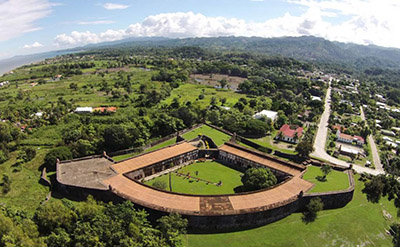 The ocean initially lapped at the rounded leading edge of the Fortaleza de San Fernando, but centuries of whatever the opposite of "erosion" is, has mysteriously moved the fort several hundred feet inland. The ocean initially lapped at the rounded leading edge of the Fortaleza de San Fernando, but centuries of whatever the opposite of "erosion" is, has mysteriously moved the fort several hundred feet inland. |
 |
Once the 16th-century Spanish discovered a new land, it wasn't long before they started vigorously conquisting it. Conquistadors started showing up in 1524, and shortly Honduras was a province of the Captaincy General of Guatemala, a kingdom which also included the current nations of Belize, Costa Rica, El Salvador, Guatemala and Nicaragua, plus the Mexican state of Chiapas.
Spain immediately began stripping it's new possession clean of everything valuable and shipping it back to the motherland. Word swiftly got out to other seafarers that Spanish ships crammed full of incalculable wealth were bobbing across the Atlantic. |
|
The navies of several nations (chiefly England, France and the Netherlands) had a distinct interest in these Spanish treasure galleons, but unless those nations were actively at war with Spain (or wished to be), they couldn't just snap the Spaniards up at their whim. Pirates, on the other hand, held no allegiance to anyone other than themselves, and were a constant threat to both Spain's treasure ships and their coastal settlements in the New World.
Many "pirates" were actually semi-state-sanctioned, like English "privateer" Sir Francis Drake (1540-1596). Among other nautical adventures, Sir Francis indulged in plenty of fancy freebootin' in the Caribbean in the 1570's, to Spain's dismay and vast expense.
|
Determined to defend their ill-gotten (though completely justified in their own opinion) riches, Spain chose the tiny town of Omoa to utilize as a strongpoint west of Honduras' capital city, Trujillo. The Fortaleza de Santa Bárbara (which was probably a beautiful starfort when the Spanish built it in 1550, but doesn't look like much of anything today) defended Trujillo, but one fort wasn't enough to defend all of Honduras, even if it was a starfort.
'Twas concluded that the bay at Omoa was the most easily-defended departure point for Spain's treasure ships along the Honduran coast. This couldn't have been too high of a priority, however, because Spain didn't get around to officially founding the town of Omoa until 1752, which had been a town prior to the Spanish showing up...but it had had a different name and been pre-Spanish so that hardly counted now did it.
A small fort named El Real was built to defend the port, but a proper starfort was swiftly deemed necessary to keep Omoa safe. Spanish King Ferdinand VI (1713-1759) authorized construction of a stellar fort at Omoa in 1759, and then immediately died. Construction of what would be the Fortaleza de San Fernando (which was named, probably, for King Ferdinand III (1199-1252), who unified the kingdoms of Castille and Léon in 1230 and was canonized in 1671) got underway in 1768, the labor being accomplished by local Indians and African slaves.
|
 |
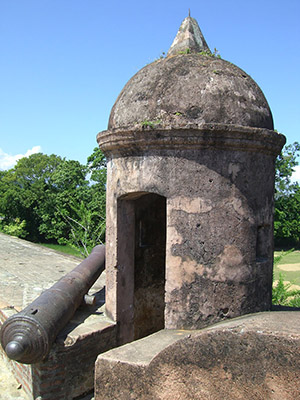 Anyone who reads the Guérite page in this site's Fortnotes section will know that I've come to terms with the garita concept, but...why would such an edifice need an actual iron spike atop it?! Could a garita potentially be used as a pointy projectile in an emergency? Anyone who reads the Guérite page in this site's Fortnotes section will know that I've come to terms with the garita concept, but...why would such an edifice need an actual iron spike atop it?! Could a garita potentially be used as a pointy projectile in an emergency? |
|
Silver mining had been Spain's primary reason for their settlement of Honduras. A great many slaves had been imported from Angola once the Indians, who had previously been tasked with digging up silver for their benevolent overlords, began to disappointingly perish in great numbers thanks to diseases from which they had no resistance, that had been introduced to them by the Spaniards.
The Fortaleza's walls were built of 31 individual vaults, of which individual vaults were used for kitchens, administrative offices, a magazine, gunsmith, barracks and the all-important chapel. The guns of the fort were all mounted on the terreplein: Along the top of the walls and bastions. Distinctively marking the Fortaleza's parade ground is a well, with what appears to be a masonry channel leading back into the fort, which one assumes would be for drainage.
No amount of drainage, however, could have made the Fortaleza a healthy place at which to exist for the unacclimated. Two Captains General of Guatemala, José Vasquez Priego Montaos (1753) and Pedro de Salazar (1771), became ill during visits to the deadly Fortaleza de San Fernando and died as a result.
|
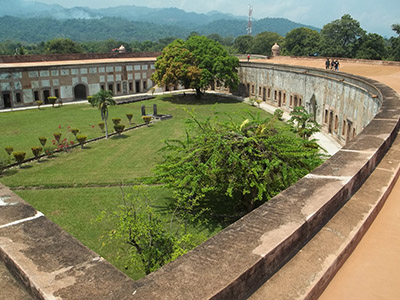 The interior of the Fortaleza de San Fernando. That appears to not be a see-saw in the fort's center, but a well and dedicated channel. The interior of the Fortaleza de San Fernando. That appears to not be a see-saw in the fort's center, but a well and dedicated channel. |
 |
The Fortaleza was built at the edge of the sea, it's rounded curtain wall designed to withstand the ravages of the mighty ocean. The coast has gained on the ocean since the 18th century, and the fort is now several hundred feet inland.
When the American Revolutionary War (1775-1783) broke out, Spain could not remain neutral as it possessed many colonies to the direct south of the wannabe United States: The land-hungry British would surely gobble up whatever caught their fancy if it were not vigorously defended...And the British surely would have loved to snatch Central America, which had been the source of vast riches for the king of Spain for centuries. With a British naval squadron based at Jamaica, a British attack seemed only a matter of time. |
|
And that time arrived on September 25, 1779, when four British warships entered the harbor at Omoa and opened fire on the Fortaleza de San Fernando. The fort, manned by Hondurans and Guatemalans commanded by a Frenchman named Desnaux, returned fire, and after a fierce artillery duel lasting a few hours, the battered ships retreated.
|
Jubilation! Dancing in the streets! The scrappy locals had defeated the mighty British Navy in the very first engagement of the war! Holes in the Fortaleza's walls had been patched up in time for the second British attempt on the fort on October 16 of that same year, which was made by twelve ships, a "large body" of soldiers and a "horde" of wicked Mosquito Indians, allies of the equally wicked British.
This battle lasted ten hours, before the British finally retreated once again, leaving behind two ships that had been battered so viciously that they had run aground. The defenders of the Fortaleza de San Fernando now considered themselves to be the greatest soldiers in the history of warfare, and immediately all got drunk, went to sleep, or did both.
|
 |
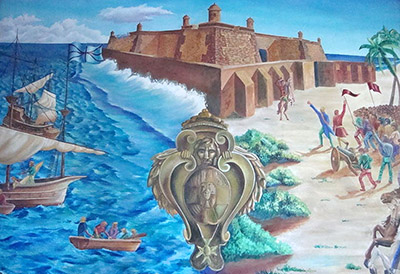 A painting depicting the Spanish defeat of the British at the Fortaleza de San Fernando in October of 1779. The British were likely thrown off their game by the CREEPIEST COAT OF ARMS EVER floating above the beach, which was that of Spanish King Ferdinand VI. A painting depicting the Spanish defeat of the British at the Fortaleza de San Fernando in October of 1779. The British were likely thrown off their game by the CREEPIEST COAT OF ARMS EVER floating above the beach, which was that of Spanish King Ferdinand VI. |
|
Predictably, someone in the British fleet said, "I would wager that every single one of those bloody pseudo-Spaniards are drunk off their arses right now," and he was absolutely correct. Having been too dedicated to revelry to set a lookout, the Fortaleza's defenders were swiftly overrun when the British returned in the early morning hours the next day. Oddly, there doesn't appear to be an heroic painting of that historic event.
|
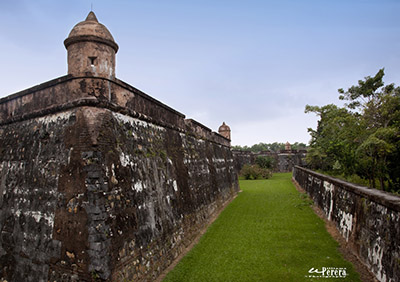 One of the Fortaleza de San Fernando's exciting bastions, enpicted by William Perera. One of the Fortaleza de San Fernando's exciting bastions, enpicted by William Perera. |
 |
The Fortaleza's new custodians remained large and in charge until 1781, when the Captain General of Guatemala, Matías de Gálvez, arrived with troops scraped together from all over Honduras and expelled the British scourge from Omoa, and indeed from Central America as a whole. By some accounts the British had not acted in a particularly courteous manner towards the locals, so it is likely that few were sorry to see them go.
Spain's sweet Central American ride ended thanks to the political upheaval that was the legacy of Napoleon Bonaparte (1769-1821). The Corsican Tyrant selected his brother Joseph (1768-1844) to be the King of Spain in 1808, immediately after having invaded that country. |
|
A series of royal abdications, restorations and general chaos before and after Joseph's brief tenure on Spain's throne added up to a great deal of uncertainty as to who was, and who should be, in charge of Spain. This was precisely what many of Spain's colonies in the Western Hemisphere were waiting for, and beginning in 1810 those colonies started falling like dominoes, declaring their independence. Honduras and Guatemala both became independent in 1821, thanks to Mexico's independence, as several Central American nations were still politically attached to Mexico.
|
Amazingly, independence from Spain did not result in instant peace and prosperity for Honduras or the Fortaleza of our current interest. 'Twas attacked once again in November of 1832, by mercenary forces commanded by a pair of Mexican Colonels named Ramon Guzman and Vicente Dominguez, accompanied by two hundred "swarthy." Which one assumes means dark-skinned persons. These swarthy Mexicans captured the Fortaleza and used it as their base of operations in their campaign to use important Honduran places as bases for operations, until they were ousted by Francisco Ferrera (1794-1851) and the Honduran Army. The rebels/mercenaries/swarthies were naturally executed.
|
 |
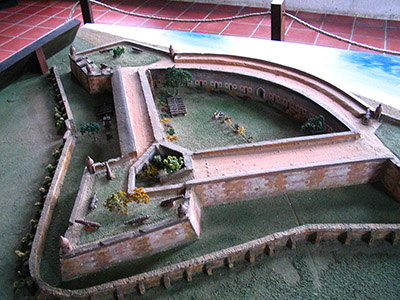 A model of the Fortaleza in it's visitor's center. A model of the Fortaleza in it's visitor's center. |
|
El Salvador, Guatemala, Honduras and Nicaragua all participated in a little furball of a war in the early 1850's, during which our Fortaleza was once again captured and occupied by an enemy. The Guatemalan Army led by José Victor Zavala (1815-1886) "easily" captured the fort in August of 1853, and were tipped back out a few months later by the Honduran Army under "President General" José Trinidad Cabañas (1805-1871).
|
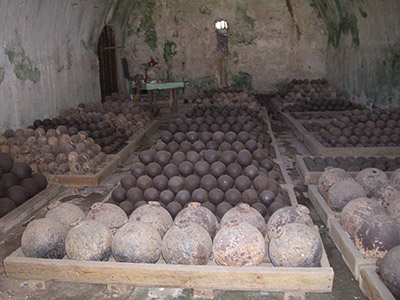 Balls, balls, balls! You never can have too many! The Fortaleza de San Fernando's magazine. Balls, balls, balls! You never can have too many! The Fortaleza de San Fernando's magazine. |
 |
Through these turbulent years, the Fortaleza de San Fernando was used as a prison, incarcerating the many folks who had displeased whomever was in charge of things at any given moment. Another Honduran "President General" by the name of José María Medina (1826-1878), who may have been the cause of the ease with which the Guatemalans had captured our Fortaleza in 1853, ordered that the fort should cease to be used as a prison, citing it's "unsanitary vaults," in 1870.
One punishment rumored to take place within those vaults was the immobilization of a prisoner beneath a slowly dripping tap, from which icy-cold water dripped onto that unfortunate person's head, slowly freezing the brain and eventually causing death. |
|
The Fortaleza was more or less abandoned for the next 89 years. Happily, it was proclaimed a National Historic Site in 1959, and work got underway to make it slightly more sanitary. Today the Fortaleza is open to the public, and has a museum next to it with exhibits of period armor and weaponry.
Endless thanks to starfort watcher Billy Seward, who alerted us to this, Starfort.com's first Honduran starfort!
|
|
|
|
|
|
 |




